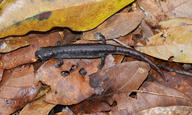|
Aquiloeurycea cafetalera (Parra-Olea, Rovito, Márquez-Valdelmar, Cruz, Murrieta-Galindo & Wake, 2010)
Coffee Grove Salamander, Salamandra de cafetal | family: Plethodontidae subfamily: Hemidactyliinae genus: Aquiloeurycea |
| Species Description: Parra-Olea G, Rovito SM, Marquez-Valdelamar L, Cruz G, Murrieta-Galindo R, Wake DB. 2010. A new species of Pseudoeurycea from the cloud forest in Veracruz, Mexico. Zootaxa 2725: 57-68. | |
 © 2011 Sean Michael Rovito (1 of 8) |
|
|
|
Description Aquiloeurycea cafetalera was originally assigned to the genus Pseudoeurycea and is distinguishable from most members of that genus by its relatively stout body, long stout legs, short digits and webbed feet. Additionally, unlike Isthmura bellii (Bell’s False Brook Salamander), it doesn’t have red dorsal spots. Aquiloeurycea cafetalera is larger, has longer limbs, and wider feet when compared to Aquiloeurycea quetzalanensis (Cuetzalan Salamander). The focal species also has a head width that is slightly smaller than Aquiloeurycea cephalica (Chunky False Brook Salamander) by about 2 mm; however, this trait might be hard to assess without direct measurements. Other relatives, like Aquiloeurycea galeanae (Galeana False Brook Salamander) and Aquiloeurycea scandens (Tamaulipan False Brook Salamander) are larger and have white spots on the tail or uniformly dark bellies unlike A. cafetalera (Parra-Olea et al. 2010). In life, these salamanders are chocolate brown on the dorsal surfaces of the head, body, and base of the tail. The tail becomes reddish brown at the tip. The snout has grey speckles and there is another grey patch above the eyes. Their irises are dark brown. The sides of the head are brown with grey speckles that increase in frequency as they move dorsally. The sides of the body are dark brown with grey specks on the upper half and pale gray with dark brown mottling on the lower half. The color of the dorsal surface of the limbs is the similar to the tip of tail in being reddish brown. The dorsal surfaces of the feet are brown with grey speckles. The ventrum is dark brown with minute grey flecks but the gular region, lateral and ventral surfaces of the tail, and the ventral side of the limbs are grey with brown specks. The ventral surface of the feet are solid brown. Preserved specimens look largely like live specimens but their venter and ventral surface of their feet fade to slate gray (Parra-Olea et al. 2010). The intensity and darkness of the brown dorsal color can vary between individuals and can range from dark brown to an auburn reddish-brown. The dorsal color can also fade to a lighter brown or brown red at the tail tip, snout, and where the legs join the body. The ventral coloration can also vary from a paler version of the dorsal color to a silver speckled color pattern (Aguilar-Lopez et al. 2017). Some individuals may also have orange-brown lichen-patterned or blotchy spots on the dorsum. Additionally, there may not be grey coloration above the eyes or grey mottling on the lower lateral surfaces (Parra-Olea et al. 2010). Distribution and Habitat Country distribution from AmphibiaWeb's database: Mexico
Life History, Abundance, Activity, and Special Behaviors Aquiloeurycea cafetalera reproduce in the rainy season between July and September and lays a clutch of about 15 eggs under decomposing logs. However, the presence of juveniles and females with ovarian eggs over the course of several months may indicate that this species has continuous reproduction (Aguilar-Lopez et al. 2017). Female produce ovarian eggs in 2 rows with 18 - 31 eggs per row. These unfertilized eggs are between 0.99 - 2.42 mm in diameter. The species exhibits female parental care with one female recorded guarding her eggs. Fertilized eggs seem to hatch a couple months after being laid as small individuals less them 32 mm in total length can be found between September and November (Aguilar-Lopez et al. 2017). Larva Trends and Threats Isolation between these fragments could lead to loss of genetic diversity and increase the risk of extinction or local extinction for this species. With this in mind, a possible solution would be to increase connectivity with coffee plantations which would provide benefits to both humans and the salamander. Chytrid fungus has not yet been investigated or recorded in this species, but it could also pose a threat (Aguilar-Lopez et al. 2017). Possible reasons for amphibian decline General habitat alteration and loss Comments Based on Bayesian Inference and Maximum Likelihood of the 16S rRNA gene, A. cafetalera is sister to A. cephalica. However, this relationship is not strongly supported. The two species are most next closely related to the clade composed of A. galeanae and A. scandens (Parra-Olea et al. 2010). The species epithet, “cafetalera” comes from the fact that it is found on coffee plantations (Parra-Olea et al. 2010). It was originally placed in the genus Pseudoeurycea (Parra-Olea et al. 2010) but was switched to genus Aquiloeurycea by Rovito et al. (2015).
References
Aguilar-Lopez, J.L., Sandoval-Comte, A., Pineda, E. (2017). ''Distribution, encounter rate and conservation status of Aquiloeurycea cafetalera (Caudata: Plethodontidae), a recently described mexican salamander.'' Phyllomedusa, 16(2), 211-224. Parra-Olea, G., S. M. Rovito, L. Marquez-Valdelamar, G. Cruz, R. Murrieta-Galindo, Wake, D. B. (2010). ''A new species of Pseudoeurycea from the cloud forest in Veracruz, Mexico.'' Zootaxa, 2725, 57-68. Rovito, S.M., Parra-Olea, G., Recuero, E., Wake, D.B. (2015). ''Diversification and biogeographical history of Neotropical plethodontid salamanders.'' Zoological Journal of the Linnean Society, 175, 167-188. Originally submitted by: Kaera Utsumi (first posted 2018-11-20) Edited by: Ann T. Chang (2022-08-23) Species Account Citation: AmphibiaWeb 2022 Aquiloeurycea cafetalera: Coffee Grove Salamander <https://amphibiaweb.org/species/7597> University of California, Berkeley, CA, USA. Accessed May 23, 2025.
Feedback or comments about this page.
Citation: AmphibiaWeb. 2025. <https://amphibiaweb.org> University of California, Berkeley, CA, USA. Accessed 23 May 2025. AmphibiaWeb's policy on data use. |



 Map of Life
Map of Life